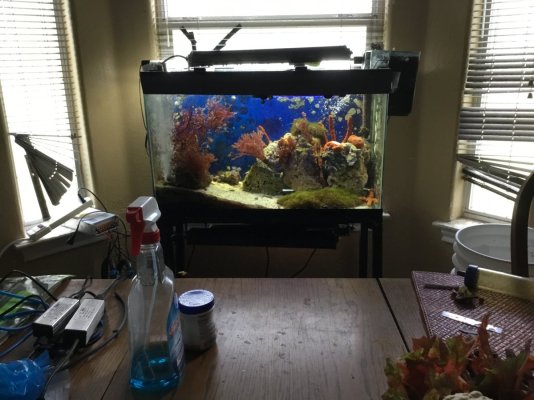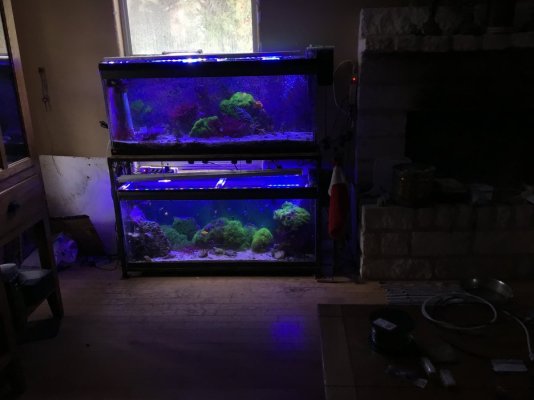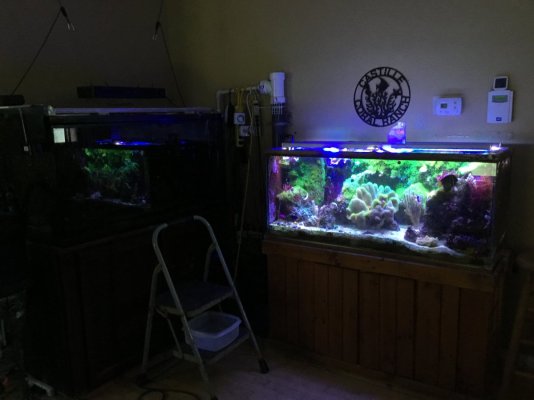What Causes Stress?
Stress is a condition in which an animal is unable to main- tain a normal physiologic state because of various factors adversely affecting its well-being.
Stress is caused by placing a fish in a situation that is beyond its normal level of tolerance. Specific examples of things that can cause stress (stressors) are listed below.
Chemical stressors:
1. Poor Water Quality - low dissolved oxygen, improper pH
2. Pollution - intentional pollution: chemical treatments -
accidental pollution: insect spray, spills
3. Diet composition - type of protein, amino acids
4. Nitrogenous and other metabolic wastes - accumulation
of ammonia or nitrite
Biological stressors :
1. Population density - crowding
2. Other species of fish - aggression, territoriality, lateral
swimming space requirements
3. Microorganisms - pathogenic and nonpathogenic
4. Macroorganisms - internal and external parasites
Physical stressors:
1. Temperature: This is one of the most important influ- ences on the immune system of fish.
2. Light
3. Sounds
4. Dissolved Gases
Procedural stressors:
1. Handling
2. Shipping
3. Disease Treatments
Alarm reaction (“fight or flight” response)
An animal is able to adapt to stress for a finite period of time. During this period the animal may look and act normal, but is depleting energy reserves because of the extra requirements placed upon it.
Disease is an abnormal condition characterized by a gradual degeneration of a fish’s ability to maintain normal physiologic functions. The fish is not “in balance” with itself or its environment.
Disease Resistance
All fish do not get sick and die each time a disease outbreak occurs. There are many factors that affect how an individual responds to a potential pathogen. The pathogen (bacteria, parasite, or virus) must be capable of causing disease.
The host (fish) must be in a susceptible state, and certain environmental conditions must be present for a disease outbreak to occur.
Defense Against Disease
Protective barriers against infection
1.Mucus (slime coat) is a physical barrier that inhibits entry of disease organisms from the environment into the fish. It is also a chemical barrier because it contains enzymes (lysozymes) and antibodies (immunoglobulins) that can kill invading organisms. Mucus also lubricates the fish, which aids movement through the water, and it is also important for osmoregulation.
2. Scales and skin function as a physical barrier that protects the fish against injury. When these are damaged, a window is opened for bacteria and other organisms to start an infection.
3. Inflammation (nonspecific cellular response) is a cellular response to an invading protein. An invading protein can be a bacteria, a virus, a parasite, a fungus, or a toxin. Inflammation is characterized by pain, swelling, redness, heat, and loss of function. It is a protective response and is an attempt by the body to wall off and destroy the invader.
4. Antibodies (specific cellular response) are molecules spe- cifically formed to fight invading proteins or organisms. The first time the fish is exposed to an invader, antibodies are formed that will protect the fish from future infection by the same organism. Exposure to sublethal concentra- tions of pathogens is extremely important for a fish to develop a competent immune system. An animal raised in a sterile environment will have little protection from disease. Young animals do not have an immune response, which works as efficiently as the immune response in older animals, and therefore, may be susceptible to disease.
Effect of stress on protective barriers
Mucus
1. Any stress causes chemical changes in mucus which decrease its effectiveness as a chemical barrier against invading organisms. Stress upsets the normal electrolyte (sodium, potassium, and chloride) balance, which results in excessive uptake of water by fresh water fish and dehydration in salt water fish. The need for effective osmoregulatory support from mucus components is increased.
2. Handling stress physically removes mucus from the fish. This results in decreased chemical protection, decreased osmoregulatory function (at a time when it is most needed), decreased lubrication thereby causing the fish to use more energy to swim (at a time when its energy reserves are already being used up metabolically), and disruption of the physical barrier against invading organisms.
3. Chemical stress (i.e., disease treatment) often damages mucus resulting in loss of protective chemical barrier, loss of osmoregulatory function, loss of lubrication, and damage to the physical barrier created by mucus.
Scales and Skin
1. Scales and skin are most commonly damaged by Handling Stress. Any break in the skin or removed scale, creates an opening for invasion by pathogenic organisms.
2. Trauma caused by fighting (Reproductive Stress or Behavioral Stress) could result in breaks in the skin or scale loss.
3. Parasite infestations can result in damage to gills, skin, fins, and loss of scales, which could create breaks in the skin for bacteria to enter. Many times, fish that are heavily parasitized actually die from bacterial infections; but the parasite problem, associated physical damage and stress response, creates a situation that allows the bacteria in the water to invade the fish, causing a lethal disease.
Inflammation
1. Any stress causes hormonal changes, which decrease the effectiveness of the inflammatory response.
2. Temperature stress, particularly cold temperatures, can completely halt the activity of “killer cells” of the immune system, thus eliminating an important first defense against invading organisms. Excessively hot temperatures are also very detrimental to fish, although the precise impact of sudden increases in temperature on the im- mune system is not known.
Antibody Production
1. Temperature stress, particularly a sharp decrease in temperature, severely impairs the fish’s ability to quickly release antibodies against an invading organism. The time lapse required to mount an antibody response gives it an advantage which may allow it to overwhelm the fish.
2. Prolonged stress severely limits the effectiveness of the immune system, thereby increasing the opportunities for an invader to cause disease.
Prevention of Stress
The key to prevention of stress is GOOD MANAGEMENT. This means maintaining good water quality, good nutrition, and sanitation.
Good water quality involves preventing accumulation of organic debris and nitrogenous wastes, maintaining appro- priate pH and temperature for the species, and maintaining dissolved oxygen levels of at least 5 mg/I. Poor water quality is a common and important STRESSOR of cultured fish and precedes many disease outbreaks.
Feed a high quality diet that meets the nutritional require- ments of the fish. Each species is unique and the nutritional requirements of different species will vary. Supplementing diets with fresh vegetables and live food is a good way to provide a balanced diet for fish that have poorly understood nutritional requirements. Fish in ponds have an advantage over fish raised indoors because of the variety of natural foods available.
Proper sanitation implies routine removal of debris from fish tanks and disinfection of containers, nets, and other equipment between groups of fish. Organic debris that accumulates on the bottom of tanks or vats is an excel-
lent medium for reproduction of fungal, bacterial, and protozoal agents. Prompt removal of this material from the environment will help decrease the number of agents the fish is exposed to. Disinfection of containers and equipment between groups of fish helps minimize transmission of disease from one population to another.
Prevention of Disease
Fish farm management should be designed to minimize stress on fish in order to decrease the occurrence of disease outbreaks. When disease outbreaks occur, the underlying cause of mortality should be identified, as well as underly- ing stress factors that may be compromising the natural survival mechanisms of the fish. Correction of stressors (i.e., poor water quality, excessive crowding, etc.) should precede or accompany disease treatments.
Stress compromises the fish’s natural defenses so that it cannot effectively protect itself from invading pathogens.
disease treatment is an artificial way of slowing down the invading pathogen so that the fish has time to defend itself with an immune response. Any stress that adversely affects the ability of the fish to protect itself will result in an ongo- ing disease problem; as soon as the treatment wears off, the pathogen can build up its numbers and attack again. Rarely would a treatment result in total annihilation of an invading organism. Disease control is dependent upon the ability of the fish to overcome infection, as well as the efficacy of the chemical or antibiotic used.
Summary
The keys to minimize disease outbreaks on your fish farm are maintenance of good water quality, proper nutrition, and sanitation. Prevention of disease outbreaks is more rewarding and cost-effective than treatment of dying fish. Disease treatments should never be applied in a haphazard fashion. When needed, chemical or antibiotic treatment should be targeted at a specific problem. Any management deficiencies in water quality management, nutritional management, or sanitation should be corrected. Fish that do not respond to a correctly administered treatment should be reevaluated by a fish health professional.
Last edited:

















